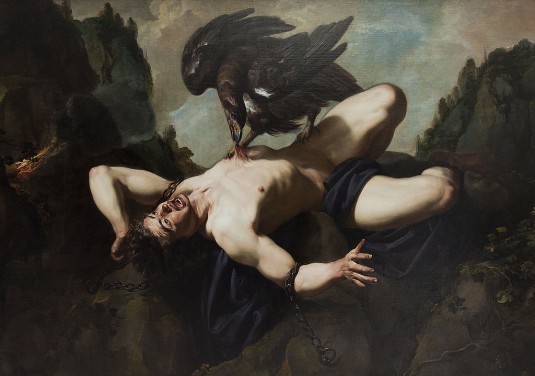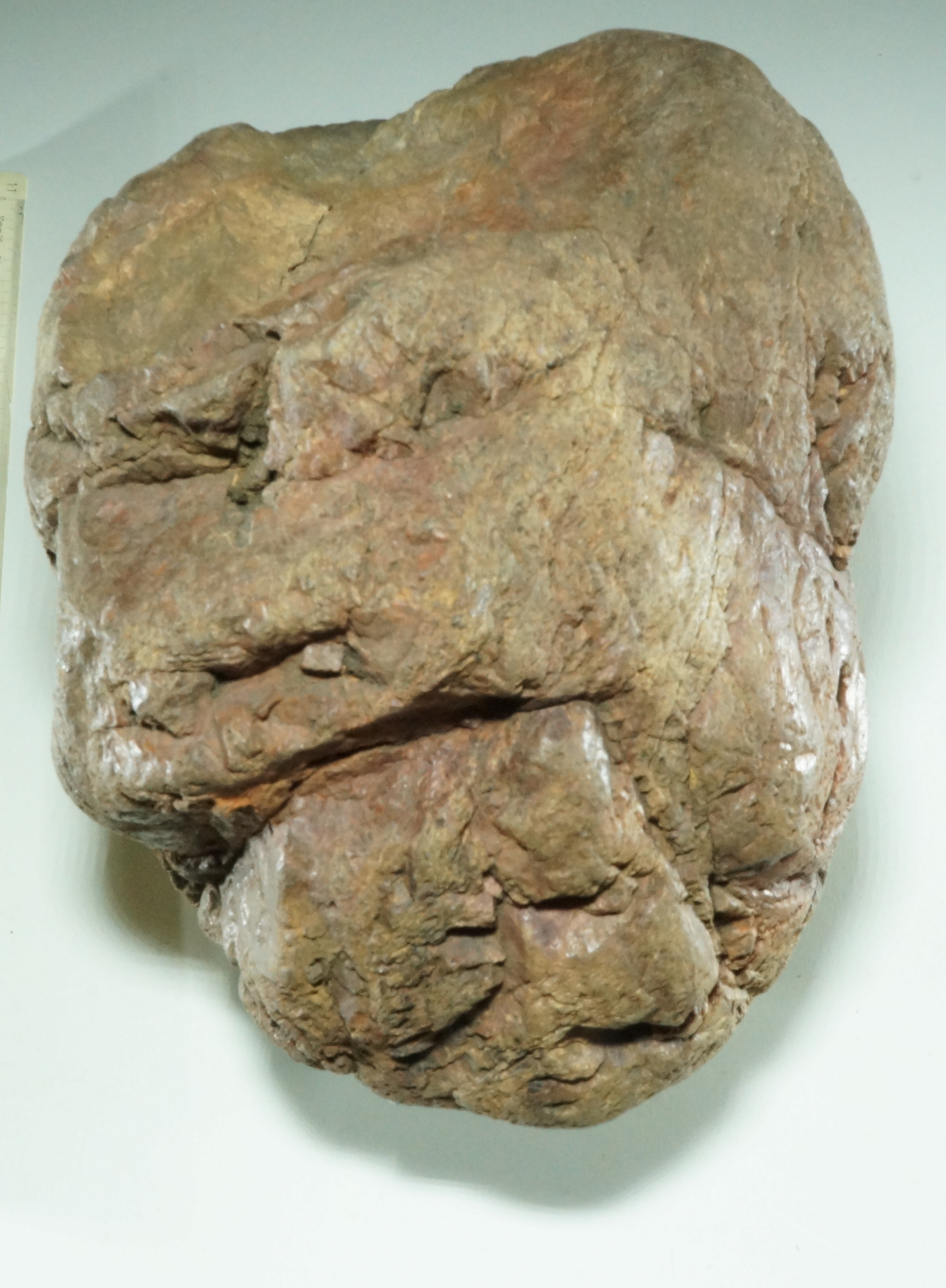.
Theo Rombouts (1597-1637) - Prometheus
https://commons.wikimedia.org/wiki/File:Theodoor_Rombouts_(1597-1637)_-_Prometheus_-_KMSK_Brussel_25-02-2011_12-45-49.jpg

[Nachgelassene Schriften und Fragmente II: [2] [“Oktavheft G”] (1918):] [see]
Von Prometheus berichten vier Sagen.
There are four legends concerning Prometheus. [The Complete Stories, New York, 1971, p. 432, last sentence changed to present.]
[Kafka did not give this piece a title, but the title follows directly from the first words. The myth or legend of Prometheus has been a popular literary motif since antiquity. There are various versions of the myth, but they differ only in additions and extensions. So why does Kafka speak of four legends? If one examines them carefully, which we will do in the following, but argues only critically-rationally, as some interpreters do, then one finds only a series of contradictions between the four versions, which are then understood in such a way that here the classical motif is deformed and dissolved, which leads to disorientation instead of the appearance of truth in the myth. If one thinks of the two attitudes described by Kafka in Up in the Gallery, then such an interpretation resembles the attitude in the first part, which must at least be supplemented by the attitude in the second part in order to come closer to the truth. This will now be attempted].
Nach der ersten wurde er weil er die Götter an die Menschen verraten hatte am Kaukasus festgeschmiedet und die Götter schickten Adler, die von seiner immer nachwachsenden Leber frassen.
According to the first he was clamped to a rock in the Caucasus for betraying the secrets of the gods to men, and the gods sent eagles to feed on his liver, which was perpetually renewed.
[The first legend largely follows the tradition, but with differences. The most important is that in Kafka only the punishment of Prometheus is described. That which is otherwise central, his deeds, his standing up for humans against the gods, is completely missing and is only addressed negatively as betrayal. This is in stark contrast to Goethe's well-known poem of the same name, where the circumstances are exactly reversed. In Goethe, the punishment is not mentioned at all.The sentence is clearly structured. The assignment of the acting subjects is already clear through this structure. Prometheus and the gods face each other as the subjects of the two main clauses, the former characteristically in the passive voice. Only in the subordinate clause is he the active subject, however, of a negatively valued action. The eagles (in the classical tradition there is one) are the subject of a subordinate clause, corresponding to their subordination to the gods. Described is a dramatic process of betrayal and retribution, the latter seemingly indefinite, as the "always" implies. This corresponds to the classical tradition, which, however, also knows an end of Prometheus' torment in two versions].
Nach der zweiten drückte sich Prometheus im Schmerz vor den zuhackenden Schnäbeln immer tiefer in den Felsen bis er mit ihm eins wurde.
According to the second Prometheus, goaded by the pain of the tearing beaks, pressed himself deeper and deeper into the rock until he became one with it.
[This ending is also the subject of Kafka's second legend, but in a form that the classical tradition does not know. One can see here a contradiction to the "always" in the first legend and thus in the second a different legend that is incompatible with the first. However, in the first legend, Kafka avoided referring the "always" unambiguously to the punishment, which would imply its indefinite continuation. Therefore, if one gets away from the idea that the second is a different Prometheus legend, one can certainly understand this second one as the next stage of an ongoing development. It describes the reaction of Prometheus to the cruel event. Here he now becomes active, but in such a way that this ends in the extreme passivity of petrification.
Nach der dritten wurde in den Jahrtausenden sein Verrat vergessen, die Götter vergassßen, die Adler, er selbst.
According to the third his treachery was forgotten in the course of thousands of years, forgotten by the gods, the eagles, forgotten by himself.
[Here the story continues. At least, if one follows the movement of the narrative and does not emphasize the contradiction that the one who has become rock still appears here as "himself". With a time lapse often found in Kafka, we now survey thousands of years in which everything ends in a general oblivion. Even the three actors who faced each other in a dramatic event in the first legend are now united in this oblivion].
Nach der vierten wurde man des grundlos Gewordenen müde. Die Götter wurden müde, die Adler. Die Wunde schloss sich müde.
According to the fourth everyone grew weary of the meaningless affair. The gods grew weary, the eagles grew weary, the wound closed wearily.
[Finally, in the fourth legend, everything ends in a general weariness, with Prometheus already no longer even mentioned. Only the wound has survived. Here the contrast with Goethe's poem is particularly evident, which at the end hurls at Zeus the challenging words, "And yours not to heed, As I!" In Goethe, the self-confident I stands at the end. What remains in Kafka?]
Blieb das unerklärliche Felsgebirge.
There remained the inexplicable mass of rock.
[Here, too, the contrast with Goethe could hardly be greater. But what does this short sentence mean? Due to the "Blieb" at the beginning, the assignment of the sentence seems peculiarly indeterminate, which may have been intended by Kafka. If one follows the movement of the text, it seems to be the end point of a development which is thus concluded without the sentence becoming part of the legend(s). Rather, it refers to the only real element of the legend, the Caucasus, to which Prometheus was forged. Then the sentence should have actually begun with "What remained was" or at least " There remained". So however one can understand the "Blieb" also in the sense of "Bliebe" under omission of the "e" or an apostrophe. Then we leave the account of the legend in the past tense and concentrate on a present problem in the sense of: If thus all actors of the legend have disappeared, then only the mass of rock would remain as inexplicable.But this brings us to the last two sentences of the text. Kafka also wrote these last, but probably wanted to place them ahead of the text. Here, the order as in the posthumous publication was chosen, because this seemed more convenient for the continuous interpretation.]
Die Sage versucht das Unerklärliche zu erklären; da sie aus einem Wahrheitsgrund kommt, muss sie wieder im Unerklärlichen enden.
The legend tries to explain the inexplicable; as it comes out of a substratum of truth it has in turn to end in the inexplicable.
[Both sentences are closely bound to each other by the semicolon. Due to the connection between "rock" and "substratum" as well as the double "inexplicable", the "inexplicable mass of rock" at the end of the legend narrative becomes a concrete manifestation of the substratum of truth, which is obviously equated with the inexplicable. At the beginning there is the "inexplicable mass of rock", the "substratum of truth". From this the legend arises. Its attempt to explain the inexplicable can only point back again to the inexplicable. It must again "end in the inexplicable."
This latter is the process Kafka describes in the four legends. It is negative, insofar as everything individual, all activities, everthing comprehensible rationally and in its relations, gradually extinguishes and ends again in the inexplicable mass of rock. But since this is at the same time the substratum of truth, one can also see the process positively: The process of reduction does not lead to complete dissolution, rather something becomes visible that appears as virtually indestructible and timeless, that in the end remains as what it always was.In terms of cultural and especially religious history, one could say that Kafka points back to a pre-mythical time when the sight of huge mountains, ancient trees and other unusual natural phenomena (cf. also) filled people with reverent awe. Myths and legends arose when people began to think about these phenomena and to classify them. Typical are the etiological legends, which try to explain the origin of unusual names, phenomena or events. (Perhaps this is why Kafka prefers to use the term "legend").

